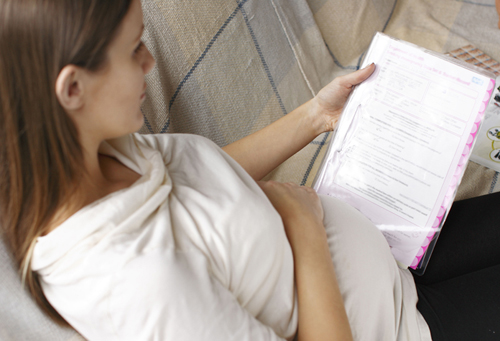You are 21 Weeks and 4 Days 129 days to go…
Your baby is producing essential red and white blood cells at a rate that is greater than your own.
Your baby today
When looking down on the baby, the nose can look quite wide
because the nasal bridge is not yet fully developed. This gives the
characteristic “button nose” shape that many babies keep throughout the
pregnancy.

Stem cells in your baby’s bone marrow
produce red and white blood cells, and platelets—the cells that clump
together to form a blood clot. Earlier in pregnancy all of these were
produced in the yolk sac ,
then the liver and spleen. Now every bone inside your baby contains red
bone marrow capable of producing blood cells. Red blood cells do not
last forever and after about 80 days are removed from the baby’s
circulation. This turnover is higher than your own, where a red blood
cell will last for 120 days.
Bilirubin is a
breakdown product from red blood cells. It’s produced in the liver and
removed from your baby’s circulation by the placenta. Because your
baby’s liver takes a few days to efficiently process bilirubin, high
levels may lead to jaundice at birth.
If jaundice does develop after birth then light phototherapy treatment
is capable of breaking down bilirubin into a form that can be more
easily excreted in your baby’s urine.
As a newborn, your baby
will be protected against infection by white blood cells and by
antibodies from breast milk, especially the colostrum .
Because of this, breast-fed babies are at a lower risk of conditions
such as asthma, cow’s milk intolerance, and food allergies.
Making sense of doctor’s lingo
Since your prenatal appointments are more regular now, it can be useful to get a handle on the medical jargon used in your pregnancy records:
Primagravida: first pregnancy
Multigravida: subsequent pregnancy
Hb: hemoglobin levels
Bp: blood pressure
Urine tests:
NAD or nil means that no abnormalities have been detected; P or alb
means it contains protein; Tr or + indicates a trace of sugar or
protein; G stands for glucose; and “other” is anything else.
Heart rate: FHH is fetal heart heard; FHHR is heard and regular; FMF or FMNF—fetal movements felt or not felt.
Your baby’s position in the uterus
is usually referred to as the presenting part or lie and there are
several terms and abbreviations used to describe this. Occiput is the
term used for the back of the baby’s head.
If you’re unclear about anything written in your pregnancy records or test results, don’t hesitate to ask your doctor to explain.

Lot—left-occipito-transverse.
The baby’s back and occiput are positioned on the left side of the
uterus at right angles to your spine.
Loa—left-occipito-anterior. The back and occiput are closer to the front of your uterus on the left.
Lop—left-occipito-posterior. The back and occiput are toward your spine on the left side of your uterus.
Rot—right-occipito-transverse. The baby’s back and occiput are at right angles to your spine on the right-hand side of your uterus.
Roa—right-occipito-anterior. The back and occiput are toward the front of your uterus on the right-hand side.
Rop—right occipito-posterior. The back and occiput are toward your spine on the right-hand side.
You are 21 Weeks and 5 Days 128 days to go…
Bellies come in all shapes and sizes and your doctor will keep track of how your baby is growing.
Your baby today
There is still plenty of room for your baby to move around. Your
baby is able to perform complete somersaults and change position
several times a day or even several times in a few minutes.

If, like some pregnant women, you are feeling big for this halfway stage,
it doesn’t necessarily mean that you’ll have a big baby. Being large
doesn’t mean that all your weight is in your belly and from your baby;
you may have put on weight on the rest of your body that doesn’t affect
your baby’s size. Women who are carrying twins or triplets do, of
course, show earlier and have much larger bellies than those expecting
one baby.
The size of your belly is, however, a good indicator of your baby’s growth, so it will be measured by your doctor .
She will measure from a point on your pubic bone in your pelvis to the
top, or fundus, of the uterus. This measurement should correlate with
the number of weeks you’re pregnant, with an accuracy of within 3/4 in
(2 cm). So, if you’re 28 weeks pregnant your belly should measure
101/4–113/4 in (26–30 cm). This symphysis fundal height (SFH) will be
written in your notes.
If your belly is found
to be significantly larger or smaller than it should be for your dates,
you’re likely to be referred for an ultrasound scan since this can give a
much more accurate measurement of your baby’s size.
Remember, though, what
you think of as huge and what your doctor feels is too large can be two
very different things! You are used to your body being a certain size
and shape and you are much bigger than you used to be, even though to
doctors you are a normal and healthy size. This can feel particularly
the case if you’re someone who has always been slim.
While it’s good to spend time
with women who are at the same stage of pregnancy as you, try not to
make comparisons. Your belly may be bigger than your friend’s, but you
may end up having a smaller baby.

… Nutritionist
| Q: |
I’ve been told to rest but will I gain too much weight?
|
| A: |
It’s important that you follow this advice, even though it can
be frustrating. Ask your doctor if you’re allowed to do gentle walking
or swimming because this will help keep you fit and burn some calories.
If you’re
eating a healthy, nutritious diet that includes plenty of fresh fruits
and vegetables, complex carbohydrates, and lean protein, you shouldn’t
gain too much weight.
Never be tempted to
diet, or go hungry just because you’re less active at the moment.
Regular meals and snacks are important. Listen to your body; if you’re
hungry, it needs fuel.
If full bed rest has
been prescribed, light exercise will be out of the question, but make
sure you establish at the outset what is and isn’t allowed. If you
aren’t active you are likely to gain some weight, but the goal of bed
rest is to ensure that you deliver a healthy baby at full-term, and
that’s worth a few extra pounds. |